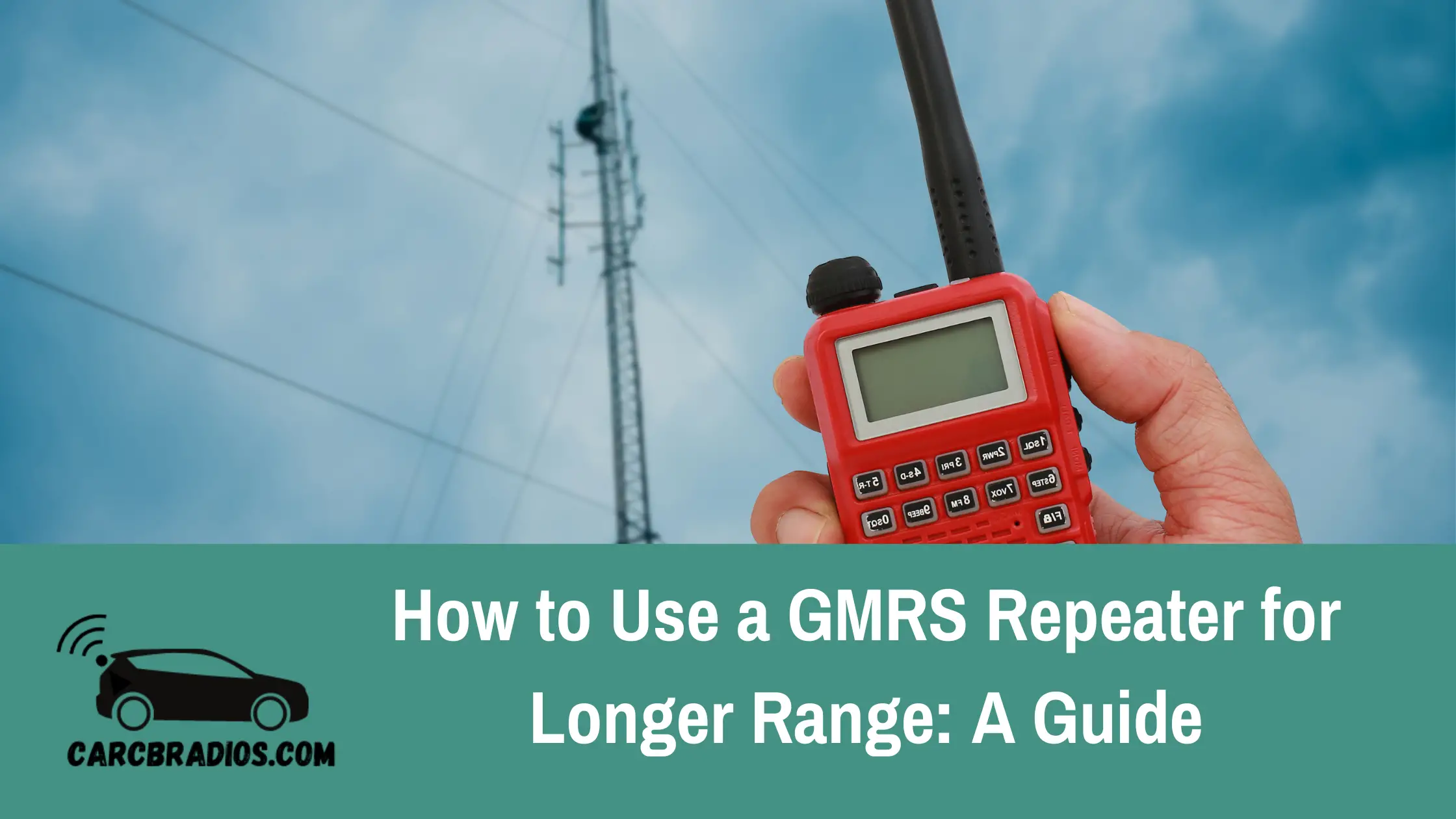By: Jeremy Neisser
As someone who enjoys using GMRS radios for outdoor adventures, I've often heard the term "repeater capable" thrown around when discussing radio features. But what does it actually mean? In this article, I'll explain how to use a GMRS repeater to increase your coverage area and stay in touch with your group over long distances.
To use a GMRS repeater, your radio must have this capability built-in. This is true for fixed mount mobiles like the Midland MXT-500 and MXT-575, as well as handheld GMRS radios like the Baofeng UV-9G. While programming varies from model to model, the basic principle is that repeater channels are already set up on the radio and can be modified by the user. These channels correspond to the 8 high power GMRS channels on the receive side, but when using them your radio transmits on an offset frequency that's 5 MHz higher. It may sound complicated, but once you understand the basics, it's easy to set up and use these features.
Key Takeaways
- Using a GMRS repeater can increase your coverage area and allow you to stay in touch with your group over long distances.
- To use a GMRS repeater, your radio must have this capability built-in and you'll need to switch to the corresponding repeater channel and possibly enter special tones to activate the machine.
- Fixed mount mobiles and handheld GMRS radios are both repeater capable, and programming varies from model to model.
How Do You Use a GMRS Repeater For Longer Range?
When talking to others in our group on a radio, we use the same frequency to transmit and receive. This is called simplex mode. However, when the distance is too far or there is an obstruction like a mountain, we cannot communicate with others. That's where GMRS repeaters come into play. They act as relay stations to pick up our signal and send it out farther than what was possible before.
GMRS repeaters are usually located on high mountaintops and can cover hundreds of square miles. But how do they work? Since we can't use the same frequency for relaying without causing interference, the repeater "listens" on a second radio frequency that is 5 MHz higher than the one we're listening on. When we transmit on a repeater channel, our radio's signal goes out on one frequency that only the repeater can hear. Then, it gets rebroadcast on the normal frequency.
To use a GMRS repeater, we need a radio that is "repeater capable." On these radios, all the switching is done automatically if we've selected one of the repeater channels. Here are some steps to use a GMRS repeater:
- Find a repeater in your area: Check online for a list of GMRS repeaters in your area or ask other radio enthusiasts in your community.
- Program the repeater channel: Once you find a repeater, program the channel into your radio. Make sure to select the correct offset frequency, which is usually 5 MHz higher than the repeater's output frequency.
- Listen for activity: Before transmitting, listen for any ongoing conversations on the repeater channel to make sure it's clear.
- Transmit: When you're ready to transmit, press the push-to-talk button and speak into the microphone. Remember to identify yourself by saying your call sign.
Using a GMRS repeater can significantly increase your range and allow you to communicate with others who are farther away. Just make sure to follow proper etiquette and listen before transmitting to avoid interrupting ongoing conversations.
How to Find and Ask Permission to Use GMRS Repeaters
Open Repeaters and the 141.3 Hz GMRS Travel Tone
When using GMRS repeaters, it's important to understand that not all repeaters are open to the public. To find and access local GMRS repeaters, myGMRS.com is a great resource. They have an interactive map that provides contact information, status (open repeater, private, permission required, etc.), and the tones required to access the repeater. It's also possible to search online for local repeater clubs and request access to the machines they maintain. Before using a repeater-capable GMRS, it's best to check the ownership status to avoid any issues.
To access "open repeaters," which are repeaters that welcome all users, it's common to set all the repeater channels to transmit a CTCSS tone of 141.3 Hz. This tone is known as the GMRS "travel tone." However, not all repeaters using this tone are considered open, so it's important to verify that the machine you're using welcomes all users before talking on it.
How to Use a GMRS Repeater – Etiquette
When using GMRS repeaters, it's essential to follow proper etiquette to ensure smooth communication and avoid any misunderstandings. While there is no one-size-fits-all approach to GMRS radio etiquette, there are some general rules that most repeater owners expect users to follow.
First and foremost, it's crucial to be courteous and respectful. Before speaking, always listen first to ensure that the channel is clear. Avoid hogging repeater airtime and use your call sign at the end of each transmission or every 15 minutes if in a conversation. It's also essential to avoid using profanity or any other language that is not appropriate for GMRS.
To ensure that you are following proper etiquette, you can listen to other licensed users talking on myGMRS.com's live audio feed. There, you can get an idea of how call signs are used and how conversations are initiated.
How Do I Set Up My Own Repeater?
If you're a licensed GMRS user, you can set up your own GMRS repeater as long as you comply with FAA rules regarding antenna height and use FCC accepted equipment. Before setting up a repeater, it's important to be aware of other repeater systems operating in the vicinity and what tones or DCS codes they use. It's also crucial to follow FCC guidance on emissions, antenna height, etc.
A ready-to-go GMRS repeater setup using a Retevis RT97 portable repeater that plugs into your vehicle's cigarette lighter can be purchased for under $400. If you have a radio that has dual-channel watch, like the Baofeng GMRS-9R, you can set one to the repeater channel and the other for the regular simplex channel. This way, you can easily switch back and forth if necessary to maintain communication. Some radios, like the Btech GMRS-V2, also have a dual PTT button, which can be useful for "talking around" the repeater when possible. It's essential to show all your users how and when it's appropriate to switch to point-to-point simplex transmission instead of going through the machine.
Why Would Anyone Need to Set Up a GMRS Repeater?
As mentioned earlier, a temporary, portable GMRS repeater can be very useful for various events, such as off-road vehicle events, cross-country marathon races, large outdoor events, or anywhere else where a central "relay" station could help radios reach each other more effectively. It can also be set up in a base-camp where there's no cell phone reception to serve as a relay station, helping handhelds that wouldn't be able to reach each other to communicate.
Other GMRS Repeater Odds and Ends
Aside from the temporary, portable GMRS repeater, there are also networked repeaters that are connected by phone lines or the internet to broadcast your signal even farther, up to nationwide. This allows one to talk from a campsite in a national forest in Utah, back to a family member in Los Angeles using a networked repeater system. An app called Zello also offers even more possibilities for nationwide GMRS communication for licensed users.
Other Solutions For Getting More Range From Your GMRS Radios
Aside from setting up a GMRS repeater, there are also other solutions for getting more range from your GMRS radios. One of which is bringing along a small directional antenna called a Yagi. This directional antenna can be set up on a 12' painters pole in just a few minutes at the campsite. The Yagi antenna has 11 dB gain, and with it, one can talk to other GMRS users via simplex and through repeaters, up to 150 miles away when camped at a high point. It's important to keep in mind that when using your GMRS mobile on repeater channels, these are 5 MHz higher in frequency. Make sure your antenna is tuned for these channels by setting its SWR or Standing Wave Ratio.
In conclusion, setting up a GMRS repeater can really expand the capabilities of your radio and allow you to keep in touch with other off-road vehicles in many areas where cell phones still don't work. It's important to note that GMRS repeaters should not be used for business purposes, only for personal and recreational use.
Frequently Asked Questions
What are the recommended GMRS repeater frequencies for longer range?
For longer range on GMRS repeaters, it is recommended to use frequencies in the 462 MHz range. These frequencies are typically used for repeater operations and have better propagation characteristics than other frequencies.
What is the maximum range of a GMRS repeater?
The maximum range of a GMRS repeater depends on several factors, including the terrain, antenna height, and power output. In general, a GMRS repeater can cover a range of up to 20 miles or more, depending on these factors.
What is the difference between a 50 watt GMRS repeater and a standard GMRS repeater?
The main difference between a 50 watt GMRS repeater and a standard GMRS repeater is the power output. A 50 watt GMRS repeater can transmit at a higher power, which can increase the range of the repeater. However, a 50 watt GMRS repeater requires a license from the FCC to operate.
Do I need a license to operate a GMRS repeater for longer range?
Yes, a license from the FCC is required to operate a GMRS repeater, regardless of the range. The license allows you to operate on the GMRS frequencies and use a repeater to extend the range of your transmissions.
Where can I find a map of GMRS repeater locations?
There are several websites and apps available that provide maps of GMRS repeater locations. One popular option is RepeaterBook, which allows you to search for repeaters by location and frequency.
What are some popular GMRS repeaters for longer range?
Some popular GMRS repeaters for longer range include the Motorola RDU4100, Kenwood TK-8360HU, and Midland MXT400. These repeaters offer high power output and reliable performance, making them ideal for longer range communications.

Hi & Welcome!
My name is Jeremy and I have been an avid car nut for many year. My first car was an 1987 Honda CRX. I put in my first Kenwood stereo, amp, 2 10" JLs and a CB Radio in it and have been an avid user of CBs and car radios for years. I'll do my best to share my tips, information and thoughts to help you with whatever question you might have, ABOUT ME
After I graduated from High School, I worked 5 years are Radio Shack and 3 years at Circuit City answering questions and helping customers with various electronics questions.

